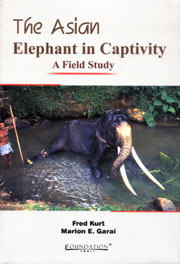Book contents
- Frontmatter
- Contents
- Preface
- Acknowledgments
- 1 Introduction
- 2 The Sri Lankan Elephant
- 3 The Captive Populations, Keeping Systems and Health
- 4 Food, Tool Use and Sleep
- 5 Musth, Reproduction, Social Integration and Stereotypy
- 6 Captive Elephants and Conservation
- 7 Base Lines and Proposals
- Appendix I
- Appendix II
- References
- Photo Gallery
- Index
4 - Food, Tool Use and Sleep
Published online by Cambridge University Press: 05 February 2012
- Frontmatter
- Contents
- Preface
- Acknowledgments
- 1 Introduction
- 2 The Sri Lankan Elephant
- 3 The Captive Populations, Keeping Systems and Health
- 4 Food, Tool Use and Sleep
- 5 Musth, Reproduction, Social Integration and Stereotypy
- 6 Captive Elephants and Conservation
- 7 Base Lines and Proposals
- Appendix I
- Appendix II
- References
- Photo Gallery
- Index
Summary
Body Growth and Daily Food Intake
In Asian elephants large quantities of food stimulate rapid body growth and reproductive success in either sex. Well-nourished females seem to invest in body growth and in their own energy and maintenance resources, but well-nourished bulls invest in slim but tall and impressive body size. In males shoulder height, next to musth is the most prominent attribute for female choice (see Section 5.3), and high quantities of food trigger the phenomenon of musth, when the testosterone level is raised, and behaviours associated with reproduction, olfactory marking and aggression are increased. In captive Asian elephants, body growth varies considerably between individuals and populations. Many females kept in western zoos are obese, with body weight upto 80% more than the weight of wild-living ones, but certain captive elephants in Asian establishments are characterized by retarded body growth, which has been attributed so far to stress during taming, overwork and malnutrition (e.g. Sukumar et al., 1988). As the remaining wild populations of Elephas maximus are threatened with extinction, the importance of captive propagation of the species increases. This applies mainly to populations of jungle based working elephants, where captive reproduction occurs regularly, but so far not on a self-sustainable basis (e.g. Mar et al., 1997; Sukumar et al., 1997). In zoos, reproduction has until recently in Europe been unimportant for the conservation of the species. Nevertheless, studies on food intake and body growth are of considerable importance for the welfare of Asian zoo elephants with a strong tendency towards obesity.
- Type
- Chapter
- Information
- The Asian Elephant in CaptivityA Field Study, pp. 86 - 153Publisher: Foundation BooksPrint publication year: 2006
- 1
- Cited by



